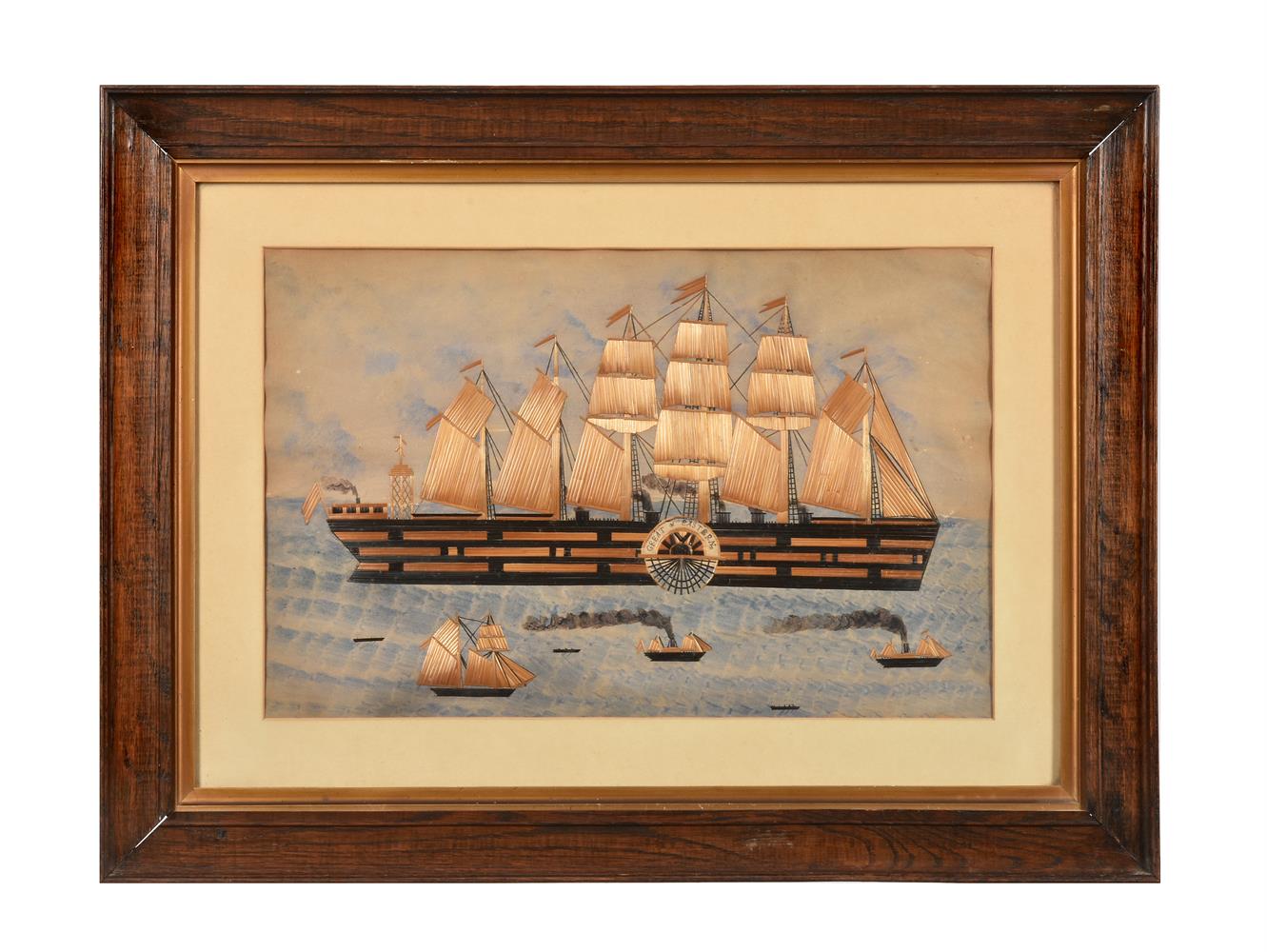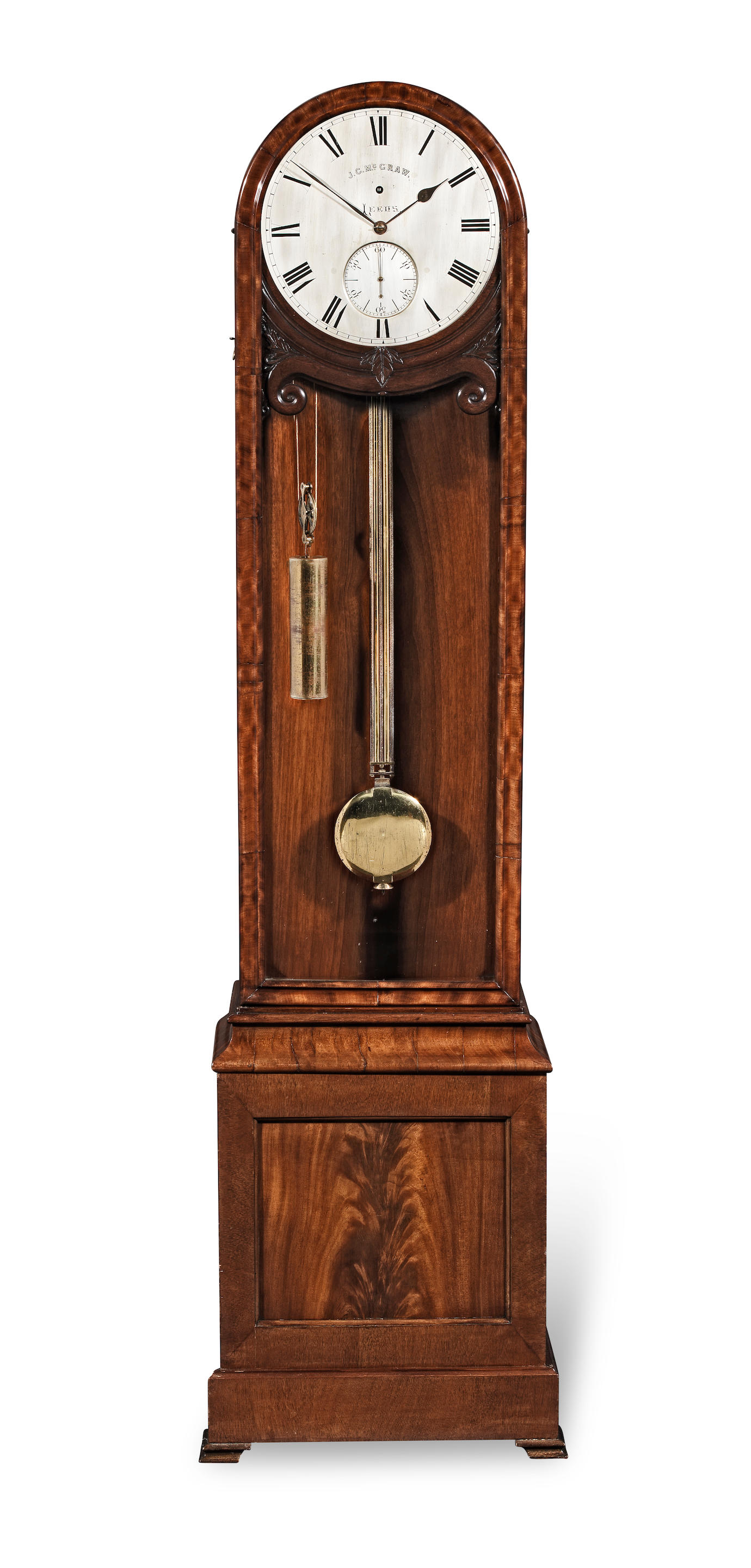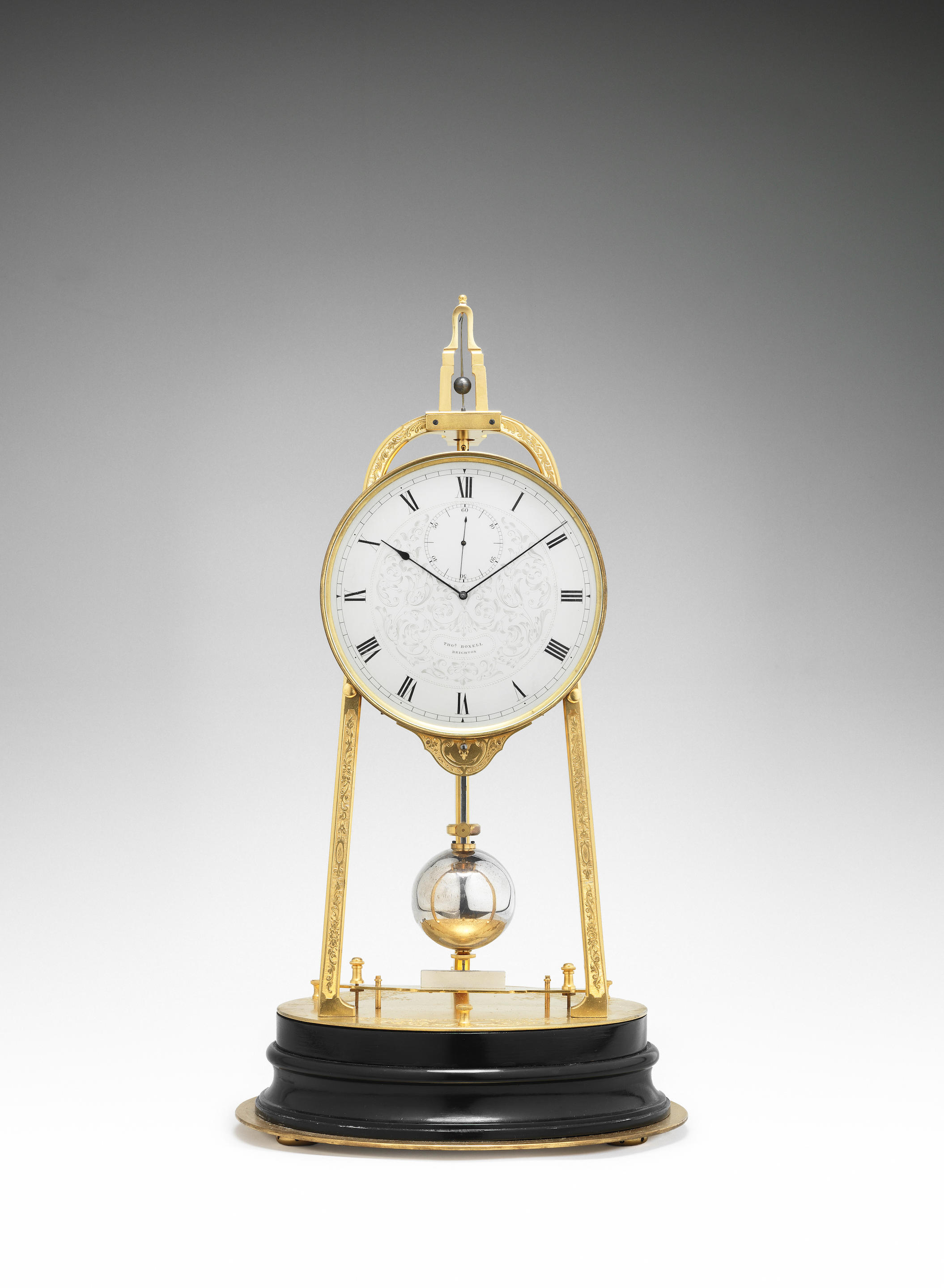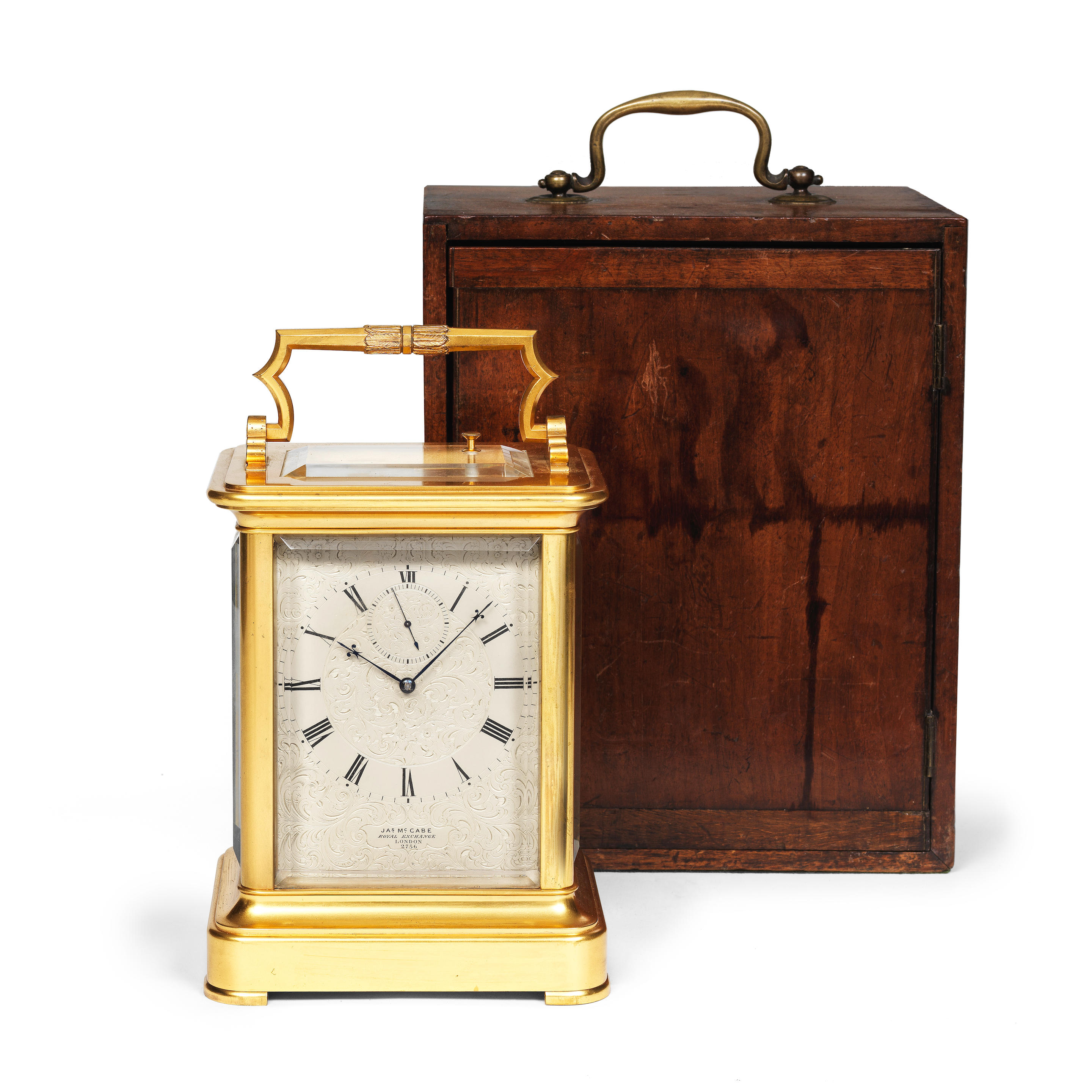A rare mid-19th century French carriage clock with chaff cutter escapementPaul Garnier, Paris number 2976 The early multi-piece case with facetted handle over a bevelled glazed inspection panel (the repeat button passing through the glass), moulded uprights and a plinth base, the solid rear door with hinged shutter opening to reveal the winding and setting squares. The Roman white enamel dial with minute track and numerals picked out in light and dark blue, the centre signed Paul Garnier Hger de la Marine Paris, above blued steel trefoil hands and a subsidiary Arabic alarm dial with blued steel setting hand. The three-spring barrel movement with Garnier's own chaff-cutter escapement with three-arm monometallic balance, and extremely delicate arbors throughout, rack striking the hours and half-hours on a bell. The back plate signed Paul Garnier Paris, and numbered on the backplate under the bell, the rear door, shutter and base also repeat numbered. Ticking, striking, sounding the alarm and repeating. Together with a double-ended winding key. 18cms (7ins) highFootnotesPaul Garnier (né Jean-Paul- was born in 1801 in Épinal, France, moving first to Luxeuil to carry out a watchmaking apprenticeship, and then to Paris in 1820 to join Lépine's workshops, before finally establishing his own business in 1825. In the 1827 Exhibition he exhibited an astronomical clock and some mantel regulators, which won him a silver medal. He would win silver medals again at both the 1834 and 1839 Exhibitions, before winning a gold medal in 1844. Around this time, he seems to have written to the formidable Antide Janvier, asking for permission to use the title 'Elève de Janvier', as Garnier, at some point, attended the free Horological school Janvier established in 1802. Janvier readily assents to this request, and Garnier used the title on his carriage clocks until about 1835, and in his written correspondences until at least 1844. Around 1835, Garnier makes use of the title 'Horloger (or Her) du Roi', which in turn is supplanted by 'Her De La Marine' after the 1848 revolution and the deposition of the monarchy. From 1830 Garnier began to make affordable, semi-massed produced carriage clocks (pendules de voyage) and could be said to have established the Parisian carriage clock industry. He was able to do this by combining a basic, easily made design with his patented 1830 escapement. This escapement, alternatively called the 'chaff-cutter', 'Gautier', or 'chopper', could be machine made, drastically reducing the time and cost of making. It is a type of frictional rest escapement, comprising of pallets in the form of a single roller (a circle with about 4/9ths of its circumference cut off at an angle and the sides ground) made of either jewel or hardened steel, the latter being more common with repaired rollers. The escape wheel is in fact two separate wheels mounted on the same arbor a specific distance apart. The wheel teeth are bevelled along the edge that interacts with the roller. The combination of basic shape and cost saving escapement meant that pendules de voyage, having previously been economically unattainable to the vast majority of people, were reduced in cost to the price of a standard mantle clock. Despite being affordable, these clocks were not poorly made, exhibiting very fine diameter pivots (even by French clock standards) and usually having rack striking, which was a desirable feature, being much easier to set than count wheel striking. The clocks would also only strike the half hour and the hour, which saved on cost compared with the more common repeaters. In the early clocks, engine turned dials, one-piece cases, and barrel stopwork were all very common. With clocks made between 1830-1840, it was common to fit a coloured-paper covered block of wood into the base of the hollow casting. In addition to carriage clocks, in 1847 Garnier presented a novel master clock and slave clock system, and at least one chronometer has been assign
A rare mid-19th century French carriage clock with chaff cutter escapementPaul Garnier, Paris number 2976 The early multi-piece case with facetted handle over a bevelled glazed inspection panel (the repeat button passing through the glass), moulded uprights and a plinth base, the solid rear door with hinged shutter opening to reveal the winding and setting squares. The Roman white enamel dial with minute track and numerals picked out in light and dark blue, the centre signed Paul Garnier Hger de la Marine Paris, above blued steel trefoil hands and a subsidiary Arabic alarm dial with blued steel setting hand. The three-spring barrel movement with Garnier's own chaff-cutter escapement with three-arm monometallic balance, and extremely delicate arbors throughout, rack striking the hours and half-hours on a bell. The back plate signed Paul Garnier Paris, and numbered on the backplate under the bell, the rear door, shutter and base also repeat numbered. Ticking, striking, sounding the alarm and repeating. Together with a double-ended winding key. 18cms (7ins) highFootnotesPaul Garnier (né Jean-Paul- was born in 1801 in Épinal, France, moving first to Luxeuil to carry out a watchmaking apprenticeship, and then to Paris in 1820 to join Lépine's workshops, before finally establishing his own business in 1825. In the 1827 Exhibition he exhibited an astronomical clock and some mantel regulators, which won him a silver medal. He would win silver medals again at both the 1834 and 1839 Exhibitions, before winning a gold medal in 1844. Around this time, he seems to have written to the formidable Antide Janvier, asking for permission to use the title 'Elève de Janvier', as Garnier, at some point, attended the free Horological school Janvier established in 1802. Janvier readily assents to this request, and Garnier used the title on his carriage clocks until about 1835, and in his written correspondences until at least 1844. Around 1835, Garnier makes use of the title 'Horloger (or Her) du Roi', which in turn is supplanted by 'Her De La Marine' after the 1848 revolution and the deposition of the monarchy. From 1830 Garnier began to make affordable, semi-massed produced carriage clocks (pendules de voyage) and could be said to have established the Parisian carriage clock industry. He was able to do this by combining a basic, easily made design with his patented 1830 escapement. This escapement, alternatively called the 'chaff-cutter', 'Gautier', or 'chopper', could be machine made, drastically reducing the time and cost of making. It is a type of frictional rest escapement, comprising of pallets in the form of a single roller (a circle with about 4/9ths of its circumference cut off at an angle and the sides ground) made of either jewel or hardened steel, the latter being more common with repaired rollers. The escape wheel is in fact two separate wheels mounted on the same arbor a specific distance apart. The wheel teeth are bevelled along the edge that interacts with the roller. The combination of basic shape and cost saving escapement meant that pendules de voyage, having previously been economically unattainable to the vast majority of people, were reduced in cost to the price of a standard mantle clock. Despite being affordable, these clocks were not poorly made, exhibiting very fine diameter pivots (even by French clock standards) and usually having rack striking, which was a desirable feature, being much easier to set than count wheel striking. The clocks would also only strike the half hour and the hour, which saved on cost compared with the more common repeaters. In the early clocks, engine turned dials, one-piece cases, and barrel stopwork were all very common. With clocks made between 1830-1840, it was common to fit a coloured-paper covered block of wood into the base of the hollow casting. In addition to carriage clocks, in 1847 Garnier presented a novel master clock and slave clock system, and at least one chronometer has been assign















Try LotSearch and its premium features for 7 days - without any costs!
Be notified automatically about new items in upcoming auctions.
Create an alert